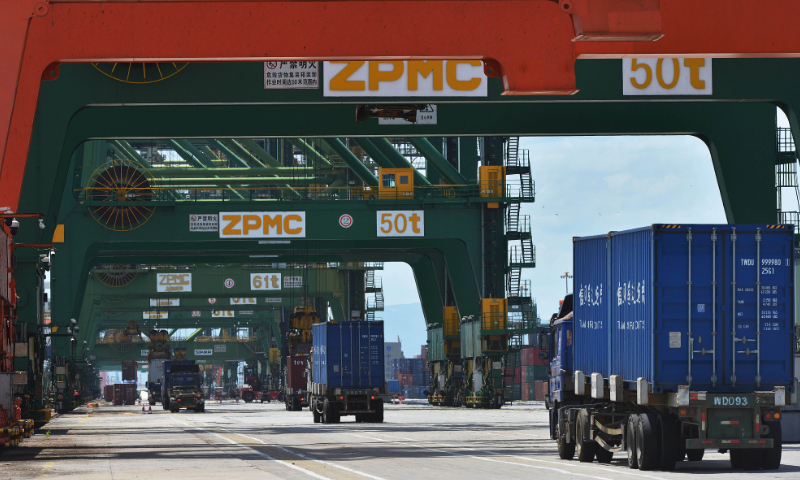
The photo taken on June 28, 2022 shows vehicles loaded with containers at Jiangyin Port, Fuzhou, East China's Fujian Province. Photo: VCG
Although China's economy showed clear signs of bottoming-out in December, the policymakers ought to firm up the foundation to usher in an eye-catching recovery in the first half of 2023, by churning out more pro-growth supportive fiscal and financial policies so long as consumer price index remains stable.
Entering January, many Chinese provinces, municipalities and autonomous regions in annual work reports to local people's congresses, have made public their new-year GDP growth targets, mostly ranging from 5-7 percent, averaging at 5.95 percent expansion. Economic powerhouses including Guangdong, Jiangsu, Shandong and Zhejiang provinces as well as Shanghai all plan their 2023 GDP growth at above 5 percent.
The prospect for the world's second largest economy is looking more optimistic, marked by the surging passenger flows at the high-speed trains, at the airports, and on the expressways for the annual family reunion in the Chinese Lunar New Year, Spring Festival, which falls on January 22. The whole country is now enveloped in a festival mood and a shopping spree, which is hardly seen in the past three years because of COVID-19.
The central government's prompt decision to revamp pandemic management from Class-A to Class-B by ending central quarantine, mass testing, intensive contact tracing, city lockdown, and reopening the country's borders, made this great transition to production and life normalcy possible. By removing one of the stumbling blocks on the road, China is anticipated to regain its growth impetus and its development speed may match pre-pandemic levels of annual 5-6 percent.
On Tuesday, the National Bureau of Statistics announced that China's GDP grew by 3 percent in 2022 to reach more than 121 trillion yuan ($18 trillion in constant prices), with per capita average GDP hitting $12,741, setting a new record and meeting the standard of medium developed countries. In 2021, the growth expanded by 8.4 percent from just 2.2 percent growth in 2020, the year the novel coronavirus pandemic broke out.
Against the backdrop of cascading global volatilities and the dim outlook of the US, Eurozone, Japan and other economies that now face the headwind of contraction or even stagflation, China's 3 percent economic growth is "not bad" at all. The results are hard won as many important industrial cities, including Shanghai, Shenzhen, Tianjin, Changchun, Chengdu and Xi'an were locked down from weeks to months in 2022 to stamp out pandemic breakouts.
After the December anti-COVID policy shift, the country has turned to a new phase, with all provinces and cities from the coastal regions to hinterland being whipped up to pursue higher growth rates by discarding past pandemic-related bounds and shackles, gearing up local infrastructure investment, fueling up residents' consumption power and exploring new channels for export in 2023.
However, the path to recovery won't be easy, as the foundation of the country's economic recovery is not very solid as the international situation remains severe and complicated, while the domestic triple pressure of demand contraction, supply shock and weakening expectations is still looming, the NBS warned on Tuesday, adding businesses still face difficulties in production and operation, scientific and technological innovation is not strong enough and people still have problems in employment. Urban jobless rate stayed at 5.5 percent as of December, while that of younger people aged 16-24 remained at 16.7 percent.
For the policymakers, it is significant to ramp up all pro-growth measures including the proactive fiscal and relatively loose monetary policy to bolster China's 160 million market entities of varied ownerships and sizes, as their thriving has a clear bearing on the country's economic future. The wide-encompassing services sector, from dining, singing, touring, catering, entertaining, caring to consulting and more, ought to greet a grand rebounding in business in 2023. High-tech manufacturing sector could have access to more investment to expand production capacity.
Also, the government needs to roll up its sleeves to ramp up domestic consumption, a major driver of GDP growth, as retail sales fell 0.2 percent in 2022 and 1.8 percent in December. Prolonged incentives on car purchase and issuance of more consumption vouchers could be considered. Helped with the free mobility of people after the COVID management policy change, retail sales may recover to 7-10 percent growth in the second half of 2023.
Fixed asset investment in general rose by 5.1 percent last year, but real estate investment plunged by 10 percent, a steep drop from previous years. This year, the government has worked out peculiarly-tailored stimulus policy to inspire home-buying, while extending banks' credit support to improve the balance sheet of housing developers.
To enhance the economy in 2023, China should also tilt toward supporting the growing private economy, the internet-based platform businesses in particular. Lately, the regulators said they have completed legal and business practice reviews of the country's major platform companies, including Ant Group and Didi Chuxing, which said on Monday it has started to sign up for new ride-hailing customers now another signal that innovative platforms will be given broader new ground to explore business and create high-paying jobs.
Therefore, barring any mishaps this year, like a worsening of the coronavirus mutation or drastic deterioration of geopolitical conflicts in the world, China is poised to achieve GDP growth of 5-6 percent this year.




